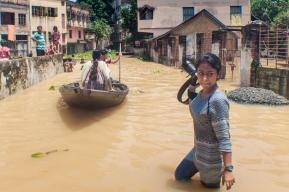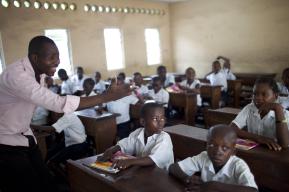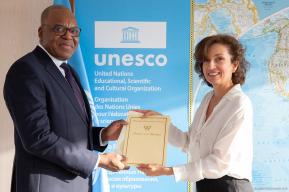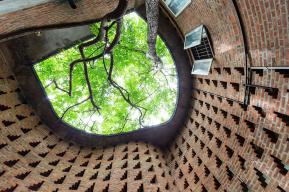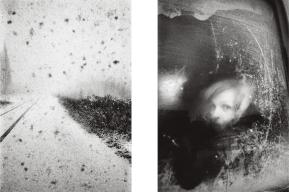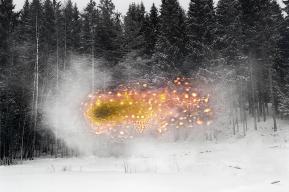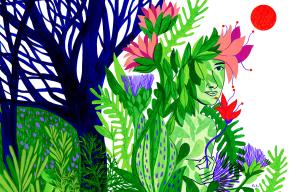Idea
The Congo Basin forest, a fragile treasure

Coralie Pierret
Journalist based in Goma (DRC)
The old colonial buildings of the University of Kisangani in the Democratic Republic of the Congo (DRC) were not always dedicated to the study of environmental sciences. Until the 1970s, the decrepit red brick buildings housed tobacco warehouses. It was then that the first shrubs were planted in the courtyard of this former factory, by a Polish biologist.
“He collected plants from all over the country and transplanted them here,” explains professor Pionus Katuala, who looks tiny among the fifty-year-old trees. Today, the botanical garden has become a veritable sample of the Congo Basin forest, where students can observe how vegetation regenerates.
The global challenge is to restore and preserve this natural treasure, which is vital in the combat against climate change. This forest area alone, which stretches across Gabon, Congo, the Democratic Republic of the Congo, the Central African Republic, Equatorial Guinea and Cameroon, represents a stock of carbon dioxide (CO2) equivalent to ten years of global emissions. In the DRC, the forest covers around 60 per cent of the country’s surface area.
The Congo Basin forest represents a stock of CO2 equivalent to ten years of global emissions
In the province of Tshopo, where the university is located, there are still some primary forests with thousand-year-old species. “If we want to preserve it, we need to train people to exploit the forest without destroying it completely,” continues Pionus Katuala. Every year, 25 to 30 young people graduate in “renewable natural resource management”. But for the dean of the faculty, time is running out. By 2020, 491,000 hectares of primary forest will have disappeared from the country.
“Our supermarket is the forest”
The cause of this depletion lies in agriculture, infrastructure development and population density, which accelerate the deforestation process. “Our supermarket? It’s the forest. Our pharmacy? It’s the forest. It’s the only way we can live,” says Jean Akaluko, President of the Turumbu people, one of the many communities living in the Congo Basin. By 2050, the number of inhabitants will have doubled to almost 370 million.
On the banks of the majestic Congo River, around a hundred kilometres from Kisangani, Ikongo Romain is one of the few villages where ecological awareness is taught from an early age. In front of the classrooms, the pupils break into their favourite song: “Baté la zamba”, which means “protect the forest” in Lingala, one of the local languages. In the school nursery, 50 coconut palms are being transplanted. “We chose to plant species that are used every day here. Our aim is to show the children the importance of trees,” explains teacher Emile Bouli Bongosso.
In this locality, the villagers are fighting with the local authorities to obtain ownership rights to a portion of the forest. The aim is to still use the forest, but sustainably. “To do this, the first step is to secure the land. The community has to seek authorization from the State to become the legal owner. And the process is tiresome – it began in 2019”, says Oulda Ruiziki, the agricultural engineer who is supervising the “community forestry” project at CIFOR, the Center for International Forestry Research.
The institute’s other challenge is to combat the abusive production of the famous makala, which means charcoal in the local language. “Until a few years ago, the wood used to make it was available close to the villages. Now you have to travel five kilometres, sometimes seven, to find it”, says George Mumberé, a researcher at CIFOR. In a country where less than 10 per cent of the population has access to electricity, the use of firewood, mainly for cooking, is a matter of survival. For CIFOR, there is no question of preventing the inhabitants from using the forest for their supplies. Rather, the Centre is seeking to encourage them to plant or use so-called improved carbonization techniques to save raw materials.
Isolated initiatives
But these initiatives are still too isolated to have a global impact. To reverse the trend and effectively combat deforestation, international mechanisms have been put in place. Such is the case with REDD – Reducing Emissions from Deforestation and Forest Degradation – which promises to remunerate countries that fulfil the contract by valuing the carbon stored in the forests. In the DRC, a number of private individuals have embarked on the adventure of selling “carbon credits” on the voluntary market to companies, institutions or individuals wishing to offset their CO2 emissions.
In Yafunga, a locality in Tshopo province, the inhabitants are still waiting for the benefits promised by Jadora. In 2009, the company’s directors succeeded in convincing them to stop clearing the forest. Nearly 780,000 carbon credits were sold, notably to Delta Air Lines and the Italian energy company Eni. But the benefits were slow in coming. As a result, the old practice of slash-and-burn agriculture, which involves clearing a wooded area by fire in order to sow it, is being revived. “What do we, the local population, gain from preserving the forest?” asks one teacher. This experience has left a bitter taste in the mouths of the local people, who felt that their land no longer belonged to them and that they were denied access to it.
Compensation mechanisms to encourage local communities to stop clearing land are often unconvincing
In the DRC, the compensation or alternatives offered to local communities are often unconvincing. In the meantime, scientists are carrying out more in-depth studies. The Congo Basin forest is far from having revealed all its secrets. Even its surface area is open to debate. Depending on the estimate, it covers between 180 and 230 million hectares.
Understanding in order to preserve
In 2020, the Yangambi research centre, located in the heart of the Congo Basin forest, will be equipped with a flow tower to gain a better understanding of the contribution of tropical forests to mitigating climate change. Standing 55 metres high and positioned just above the canopy, the tower collects data to study the exchange of greenhouse gases between the forest and the atmosphere.
In a building left over from the colonial era, Elassi Ramazani has been collecting, storing and preserving plants for several decades in his herbarium, the largest in Central Africa. “This is where we find our memories”, insists the botanist in front of his shelves of files, carefully arranged in alphabetical order. Almost 40 per cent of the Congo’s vegetation can be found here. But time is running out. “The imminent danger is not from outside, but from within, from us Congolese. There are so many of us! How are we going to slow the destruction of the forest?” asks Elassi Ramazani.

The DRC has proclaimed itself to be a “solution country” for the climate crisis, thanks to the carbon sink its forests represent. In 2021 the Central African Forest Initiative (CAFI) pledged US$500 million to the DRC. But the sale of oil and gas concessions in July 2022 is a cause for concern, especially as some of the exploration licences are located in the central Congolese basin, which is rich in peat bogs. This fragile carbon sink could be released into the atmosphere if its ecosystem were to be disturbed.
The Yangambi Biosphere Reserve, a biodiversity sentinel
In 1976, the Yangambi Biosphere Reserve, situated in the heart of the Congo Basin in the northeastern part of the Democratic Republic of the Congo (DRC), was one of the first to join the UNESCO World Network of Biosphere Reserves.
Today, it is again being a pioneer. In March 2022, an initiative was launched thanks to funding from Belgium to make this biosphere reserve a hub of knowledge on climate and biodiversity. The University of Ghent (Belgium), one of the main partners in the project, has installed the 55-metre-high Congoflux tower there. It rises 15 metres above the forest canopy and collects data on the exchange of water vapour and greenhouse gases such as carbon dioxide, nitrous oxide and methane between the atmosphere and the forest. These data will improve our knowledge of the role that forests play in sequestering carbon and therefore in limiting climate change.
This information is particularly important for climate change adaptation planning at the local level, but also worldwide. The University of Ghent has obtained validation of the data by the European Integrated Carbon Observation System (ICOS), which allows it to share them globally.
The project also calls for the Centre for Biodiversity Surveillance (Centre de surveillance de la biodiversité, CBS), located in nearby Kisangani, to monitor ecosystem health using thermal cameras and drones and by collecting environmental DNA (eDNA) samples, a non-invasive technique for identifying species in natural environments.
Coordinated by UNESCO, the project is being implemented with the Regional Postgraduate School for the Integrated Management of Tropical Forests and Lands (Ecole régionale postuniversitaire d'aménagement et de gestion intégrés des forêts et territoires tropicaux, ERAIFT); the National Institute for Studies and Research in Agronomy (Institut national des études et recherches agronomiques, INERA); and the Man and the Biosphere Programme department in the Ministry of Environment and Sustainable Development.

In the same issue



